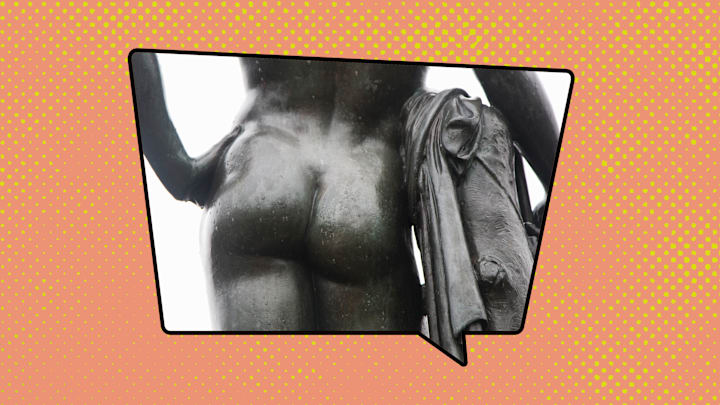There’s no shortage of words for asses. Hiney, butt, can, cakes, money-maker, and (in the U.S., anyway) fanny are readily available.
But when talking about the fundament, some terms have slipped through the crack (sorry) of lexical history. So please enjoy these old and enjoyable terms for the hindquarters.
1. Downstairs
This tasteful euphemism has been recorded since the 1940s, and it’s still in use in recent times, as seen in a 2000 example from The Guardian (which is rather non-tasteful, apologies): “You all know what happens downstairs when that happens (loose as a goose I was, if you’ll pardon my anatomicals).” Kudos to anatomicals as a superb euphemism for some messy bathroom business.
2. Prat
Though prat came to mean “fool” or “buffoon”—or “ass,” if you will. In addition to other meanings, it referred to the hiney in the 1500s, according to the Oxford English Dictionary (OED). That’s why a pratfall is when someone falls on their prat.
3. Sitting Place

This is one of the most logical butt euphemisms. It’s been recorded since the 1500s, and is labeled obsolete, but who knows why since it seems timeless. A 1607 use from Edward Topsell’s The History of Four-footed Beasts asks readers to consider or literally grasp a hirsute situation: “Take the hairs that grow behind on the Goats sitting place.”
4. Latter End
Latter end has been in use since the 1300s for all sorts of closing chapters, which have sometimes included the badonkadonk. An 1852 example from R. Coombes’s Aquatic Notes offers acrobatic advice: “Throw the body forward with a spring, as if your latter end was made of Indian-rubber.”
5. Crupper

The OED defined the original sense of this term, which popped up around 1300, as “A leathern strap buckled to the back of the saddle and passing under the horse's tail, to prevent the saddle from slipping forwards.” From there the term spread to mean a horse’s butt, and then, by the 1500s, anyone’s. There’s no relationship to another ass-adjacent word—crapper.
6. Rusty-dusty
According to Green’s Dictionary of Slang, this term is based on “the implication that someone has been sitting around doing nothing; thus they are rusty and dusty from lack of movement.” The 1942 Count Basie Orchestra song “Harvard Blues” contains the line “Mama, get up of your big fat rusty dusty.” Rusty-dusty, like mumbo-jumbo, flim-flam, and palsy-walsy, is an example of reduplication—a process that makes language go helter-skelter.
7. Suburbs

This geographical term is recorded by Green’s and appears in a violent 1878 example from the Dundee Evening Telegraph, describing an assault with some vivid and unique language: “A young man [...] hit him a belt back of the ear, fetched him another on the nose, and planted such a kick in his suburbs as to send him headlong over an ash heap.”
8. West Side
Who needs a compass when there’s the OED, which lets us know the duff is on the west/western side? The term west side has been around since the 1820s and can apply not only to the buttocks, but the buttock region, as seen in an 1829 reference to “the western side of your gown.” It’s good to know the wazoo is west.
9. Beam

Are you “broad in the beam”? Then your west side is sprawling. Since the 1920s, beam has been used to refer to folks wide in the butt or hip area, as explained in a 1960 example from Ian Cross’s The Backward Sex: “‘I’m too broad around the beam.’ ‘What do you mean? ...’ ‘My hips, silly ... I’ve got wide hips.’”
10. Labonza
The term labonza first referred to the stomach in the 1930s, but by the nexr decade, it had traveled south. Harold Wentworth and Stuart Berg Flexner’s Dictionary of American Slang records this use: “The day’s losses—$39,374! Quite a kick in the labonza.”
11 Back-porch

Green’s Dictionary of Slang has recorded one of the more logical terms for the buttocks, back-porch, since 1950. There’s a memorable use in John Eagles’s 1953 novel The Hoodlums: “That doll could put a piece of chalk in her back porch, spell Mississippi and dot all the I’s.”
12. Ultimatum
Ultimatum as a euphemism for the buttocks was only recorded a few times in the 1820s, but boy is it a fun one. Many physical endpoints have been used to describe our physical bottoms, so why not a more rhetorical bottom line? Charles Molloy Westmacott used the term in his 1823 book Points of Misery: or, Fables for Mankind: “Old Brummagem and the fat lady being thrown head downwards, formed an excellent step-ladder with their ultimatums for the purpose.”
13. Catastrophe
This term has a Shakespearean pedigree, appearing in Henry IV Part 2, in a memorable line: “Away, you scullion! you rampallian! you fustiliarian! I’ll tickle your catastrophe!” With harsh words like that, it’s safe to say the promised tickling isn’t the friendly sort, and this is a Renaissance flavor of the timeless threat “I’ll kick your ass!”
